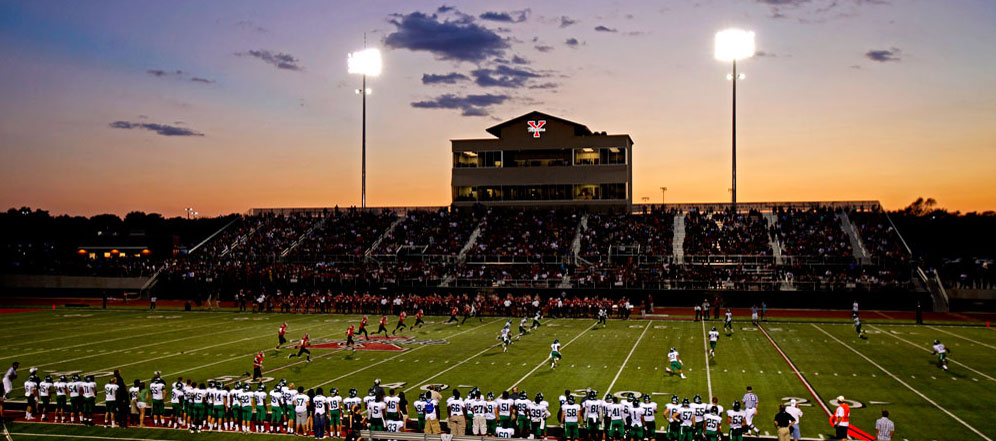More than a Game
 It was a warm Texas day in the fall of 2008. Just getting out of the last class of the day, Brett Vaughn wandered towards the field house to prepare for that night’s game. As he entered the locker room the smell of freshly washed jerseys and the noise of rambunctious teenage boys filled the air. Friday was the day of the week the players had all been waiting for: game day. The first few weeks of games had been put behind them and now the team was in high hopes of finishing the season strong. The boys talked up their opponents and chanted loudly as they put on their pads, uniforms, and cleats. As Coach entered the locker room a silence fell across the players. Everyone present took a knee and bowed their heads; eyes closed, coach began to pray.
It was a warm Texas day in the fall of 2008. Just getting out of the last class of the day, Brett Vaughn wandered towards the field house to prepare for that night’s game. As he entered the locker room the smell of freshly washed jerseys and the noise of rambunctious teenage boys filled the air. Friday was the day of the week the players had all been waiting for: game day. The first few weeks of games had been put behind them and now the team was in high hopes of finishing the season strong. The boys talked up their opponents and chanted loudly as they put on their pads, uniforms, and cleats. As Coach entered the locker room a silence fell across the players. Everyone present took a knee and bowed their heads; eyes closed, coach began to pray.
"Dear Lord, we pray for strength tonight. We ask that you watch over us as we play the game. We ask for strength in our tackles, spirit, and faith. Most importantly, we ask for a win. Amen."
Over the silence, the crowd above lets out a loud cheer in preparation for the team to run onto the field. The boys stand, pull their helmets over their heads, and begin the familiar walk toward their playing ground. As the school’s anthem blares from the band, the players run through a banner made by the cheerleaders that reads: “Bring the Wood,” and the fans in the bleachers go wild.
First quarter, second quarter, halftime. All of a sudden, it is the final quarter of the game. Brett looks up at the clock. There are 15 seconds left, 4th down, 20 yards to go. A million things run through Brett's head at this moment. When did he get here? It's his last district game of his freshman year as quarterback of his high school football team, but it seems like just yesterday that he threw his first football, and now the game depends solely on him. "Down, Set, Hut!" He pulls back, looking for an open teammate. In the end zone, he sees someone wide open, but as he goes to throw, he is tackled. Hard. Hitting the ground, he hears something pop and knows that everything will be different from here on out.
It only took a few minutes of Brett lying on the field for everyone in the bleachers to know that something horrible had happened. The eerie silence of the crowd was broken when an ambulance arrived, taking him off on a stretcher, his family in tow. After hours of waiting in excruciating pain, the doctor informed Brett and his family that he had torn his anterior cruciate ligament, or ACL, and he would have to undergo surgery followed by months of rehabilitation.
“I told him he would have to work his butt off and just come back stronger,” explained Bobby Vaughn, Brett’s father, “That is the only advice I could really give him because I knew how hard it was going to be to come back from that kind of injury.”
Over the past forty years, the state of Texas has seen some of the most admirable football players call it quits due to serious injuries. A study done by the Sports Medicine Committee of the Texas Medical Association in 1989 evaluated 100 high schools’ football players during a single football season. Of the 4,399 student athletes in the varsity football programs who participated, 2,228 of them suffered from an injury at some point in the season. 137 of these cases resulted in player hospitalization, documenting them as severe injuries. Although deadly results due to injuries on the field are rare, many players who suffer from a severe injury never get the chance to play the game again. Examples of this cause and effect reach back all the way to the infamous story of John McClamrock in 1973. A junior at Hillcrest High School in Dallas, John was a member of the Junior Varsity football team. Their opponent that weekwas Spruce High School, and in hopes of showing his coaches that he had what it took to become a Varsity player, John went into the game determined to play his best. This young player, however, did not know that after this game he would never walk again.
Skip Hollandsworth, in an article published in a 2009 issue of Texas Monthly, wrote about John’s last tackle:
“On Hillcrest’s opening kickoff, [John] burst through the Spruce blockers and zeroed in on the ball carrier. He lowered his head, and as the two collided, John’s chin caught the runner’s thigh. The sound, one teammate later said, was like ‘a tree trunk breaking in half.’ John’s head snapped back, and he fell face-first to the ground.”
After several spinal surgeries, John’s doctors pronounced him completely paralyzed from the neck down. According to Eddie Canales, a father to an injured Texas high school football player, there are approximately two catastrophic spinal-cord injuries a year in Texas alone. With such a chilling statistic, how can parents let their son play such a life-threatening sport?
After spending his summer working hard in physical therapy, Brett returned to the game in the summer of 2009.
“When I tore my ACL [freshmen year], it felt like life hit me in the mouth,” Brett said, “But all I’ve ever heard is ‘Bring the wood! Bring the wood!’ So I did and I came back to be a better player than I thought possible.”
The recovered player led the JV team to the 7-on-7 state championship game and seemed to have never lost his stride. During his sophomore year he was a starter in every game and played fantastically, but then he had another set back. In the 2009-2010 season, Brett tore his only-good ACL, resulting in a surgery to the other knee.
“That was hard for me and him to handle because not too many people can come back from that much trauma,” said his father, “but he just said ‘I will have to work that much harder.’”
After months of rehabilitation to his knee, Brett regained his strength a second time and returned to the Hebron Varsity team as a junior. He started as the outside linebacker and backup quarterback. As a result of his knee injuries, however, Brett had lost a lot of speed that had made him a standout player.
“The Head Coach asked if he could gain about 25lbs and play defense line for us,” Bobby explained, “…as a junior my son was only about 6ft, 200lbs. Most of the guys in 5A football that play that position are 250lbs or bigger.”
Against the odds, Brett said “yes” to the newly offered position and put on 35 pounds. At the beginning of his senior season, he won the starting position and started every game. His teammates voted him captain and team leader. At the conclusion of his high school career, Brett was chosen as First Team All District, and has recently accepted a football scholarship at Austin College.
“Through [playing football], [Brett] has learned so much and is prepared for life,” Bobby said, “Whatever life throws at him, he will find a way to win! I’m not so sure any Dad could teach their kid that lesson, but football did and I’m so thankful for that.”
Texas is known for producing some of the most valuable high school football players, on and off the field. High school football in the Lone Star state is held at high expectations, not only as a sport but also as a way for a community to be proud of its own. Take the recent television show “Friday Night Lights” for example. Based in the fictional town of Dillon, Texas, the show revolves around the town’s high school football team as well as the community that supports it. Throughout the five seasons, viewers joined the journey of faith, love, and loss with the characters presented in the show. For those who followed and watched the show, football became known as more than just a sport to a small Texas town; it became a way of life.
“There is no such thing as Texas high school football ‘hype’,” Bobby Vaughn explained, “we are the best and produce the best players.”
In the article “Arms Race”, published in 2010 in Texas Monthly, Brian Curtis describes Texas high schools as turning into a “quarterback assembly line. The state is churning out great passers like Colt [McCoy] every year, and now those quarterbacks are beginning to overrun college football and the NFL.” In the 2009-2010 football season, Texas high school players accounted for 24 of the 120 starting quarterbacks in big-time college football. Curtis mentions the old joke about Texans and their football: there are only three sports in Texas: summer football, fall football, and spring football. After viewing the show “Friday Night Lights,” one can only wish to experience this life style firsthand. It proves to be so much more than just a game.
“Football, to me, is life,” said Bobby Vaughn, “Life, like football, has obstacles, and you have to overcome them.”
As a second-generation coach, Bobby has known nothing better than to revolve his life around the game. He is currently a coach at Hebron High School in Lewisville, Texas, and he has been there for ten years.
“The best part about being a coach is seeing 14-year-old boys become men,” he explained, “[I watch them] learn that they can push themselves a lot further than they think.”
As people that are three generations deep in players, football is a huge part of the Vaughn family, but they are just one example of how important the sport is to thousands of families all over Texas, especially to those personally involved with a high school team or who have played themselves.
“Football has shown me how to be strong and compete,” Bobby said, “When things go bad and life is hard I know I will be able to handle the situation. I will never quit or give up on my family, friends, or my life.”
Looking past the injuries, the hot summer three-a-days, the stress of making the perfect pass, Texas’ love for high school football goes much deeper than just the game. It is an evolving lesson to learn through losing and winning. It is butterflies before a big game on Friday night. It is the sound of a crowd cheering for their team. It is hope. It is faith. It is life. It is Texas high school football.
